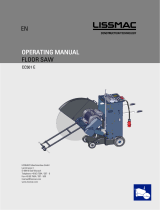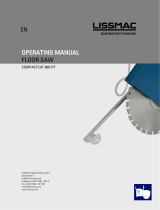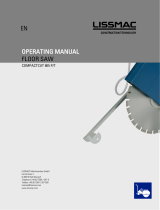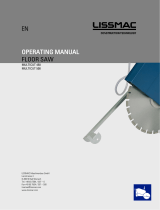
1/58
OPERATING MANUAL
FLOOR SAW
CC601 E
LISSMAC Maschinenbau GmbH
Lanzstrasse 4
D-88410 Bad Wurzach
Telephone +49 (0) 7564 / 307 - 0
Fax +49 (0) 7564 / 307 - 500
lissmac@lissmac.com
www.lissmac.com
EN

2/58

3/58
Imprint This operating manual is for:
LISSMAC floor saw
CC601 E
Company headquarters:
LISSMAC Maschinenbau GmbH
Lanzstraße 4
D - 88410 Bad Wurzach, Germany
Phone: +49 (0) 7564 / 307 – 0
Fax: +49 (0) 7564 / 307 – 500
lissmac@lissmac.com
www.lissmac.com
Original operating manual
Issue date: 11-2021
Save this manual for future reference!
Disclosure and copying Distribution and duplication of this manual in any form, or use of the content are prohibited unless
permitted in writing.
Violations shall be subject to compensation. All rights reserved for patents and registered designs or
design patents.

4/58
GENERAL SAFETY NOTES
Warning notices and symbols in this manual
SIGNAL WORD
Type and source of the hazard
Consequence of non-compliance.
Action to avert the danger
The signal word after the hazard symbol indicates the level of danger:
DANGER
This signal word indicates an extremely dangerous situation. If the situation is not avoided, it
will result in fatal injuries. The hazard may be specified on the danger symbol.
WARNING
This signal word indicates a potentially dangerous situation. If the situation is not avoided,
fatal or serious injuries could result. The hazard may be specified on the danger symbol.
CAUTION
This signal word indicates a dangerous situation. If the situation is not avoided, medium and
minor injuries result. The hazard may be specified on the danger symbol.
NOTICE
This signal word indicates a situation, which contains dangers to physical objects. If the
situation is not avoided, damages to property result. The signal word is given without a danger
symbol.
Important information is marked with an “i”.
Request for operator action:
The specified sequence of actions facilitates orderly and safe handling of the machine.
Instructions to the operator
The warning notices in this manual are not universally complete.
Lissmac cannot foresee every potential hazard.
Appropriate safety rules and precautions with respect to working methods and operation must
be implemented, as with any other machine.

5/58
Warning and safety notices:
Read the operating manual
Wear hearing protection
Wear safety goggles
Wear gloves
Wear a protective helmet
Wear suitable work clothes and wash dusty clothes
Remove the power plug before working on the machine
Risk of cuts on rotating tool
Wait for all parts to stop moving.
Do not relocate the machine while the tool is rotating
Danger due to ejected parts
Danger of high electrical voltage
Risk of being pulled in by open belt drive
Danger of cuts and amputation through rotary cutting tools
Warning of electric shock due to damaged power lines.
Lifting point for crane transport
Do not use high-pressure cleaners
No use by unauthorized persons
Do not perform maintenance while the motor is running

6/58
Do not perform maintenance while the motor is running
Disconnect from mains before performing maintenance work
Parking brake
Clutch for traction drive
Do not exceed 25A current consumption during cutting operation
Running direction of saw blade
Instructions for avoiding damages
Only store and transport the unit in an upright position
Sound power level of the machine
Visual inspection
Spray-on grease
Grease gun

7/58
OPERATING MANUAL
Preface This operating manual makes it easier to become acquainted with the machine and make full use of it
as intended.
The operating manual contains important information on how to operate the machine safely, properly
and economically. Following it will help to prevent hazards, avoid repair costs and downtimes, and
increase the reliability and service life of the machine.
The operating manual should be supplemented by instructions based on existing national accident
prevention and environmental protection provisions.
The operating manual must be constantly available at the place of use of the machine.
The operating manual must be read by every person who works with or on the machine and the
provided instructions must be followed, e.g.:
operation, including set-up, rectification of faults during the work routine, removal of production
waste, maintenance, disposal of operating and auxiliary materials
Maintenance (servicing, inspection, repair) and/or
Transportation.
In addition to the operating manual and the binding accident prevention regulations applicable in the
user's country and at the place of use, the acknowledged rules for safe and correct working practices
must also be observed.
Required tool: A tool in the form of a saw blade is required to operate the floor saw. These tools can be purchased
from the manufacturer.
further documents LISSMAC does not assume responsibility or liability regarding the completeness of further
documentation.
Changes and reservations We strive to keep this operating manual correct and up to date. In order to maintain our technological
advance, it may be necessary to make changes to the product and its operation without advance
notice. We assume no liability for disruptions, downtime and damages that thereby result.
Target group These operating instructions are aimed at semi-skilled and trained personnel in the fields of structural
mechanics, concrete cutting technology, road construction, and civil engineering.

8/58
Table of contents
1. Properties & advantages ................................................................................................. 9
2. General safety information ............................................................................................ 10
2.1. Intended use policy..........................................................................................................10
2.2. Organizational measures .................................................................................................11
2.3. Choice of personnel and qualifications; fundamental obligations ...................................12
2.4. Safety notices regarding the operating phases ...............................................................12
2.5. Note relating to special types of danger .........................................................................14
2.6. Transport .........................................................................................................................15
2.7. Packaging and storage ....................................................................................................16
2.8. Environmental protection ................................................................................................16
2.9. Disposal ...........................................................................................................................16
3. Device description ......................................................................................................... 17
3.1. Machine part names........................................................................................................17
3.2. Technical data .................................................................................................................20
3.3. Sound power level ...........................................................................................................21
3.4. Hand-arm vibration ..........................................................................................................21
3.5. Electrical hazard ..................................................... Fehler! Textmarke nicht definiert.
4. Transport......................................................................................................................... 23
4.1. Transport position ...........................................................................................................23
4.2. Lifting by crane ................................................................................................................24
4.3. Tie down for transport .....................................................................................................25
5. Commissioning ............................................................................................................... 26
5.1. Consumables ...................................................................................................................26
5.2. Tools (saw blade) ............................................................................................................26
5.3. Establish power connection.............................................................................................26
5.4. Parking brake ...................................................................................................................27
5.5. Establish water supply ....................................................................................................27
5.6. Adjusting the lowering speed of the saw blade ..............................................................27
5.7. Handle bar adjustment ....................................................................................................28
5.8. Installing/replacing the saw blade (tool) .........................................................................28
5.9. Switching from right-hand to left-hand cutting ...............................................................30
6. Operation ........................................................................................................................ 31
6.1. Safety ..............................................................................................................................31
6.2. Pre-cut preparations ........................................................................................................33
6.3. Switching the machine on and off ...................................................................................34
6.4. Phase inverter ..................................................................................................................35
6.5. Relocate by hand .............................................................................................................35
6.6. Traction drive ...................................................................................................................36
6.7. Lower/raise the saw blade and set the cutting depth .....................................................37
6.8. Cutting with the floor saw ...............................................................................................38
6.9. Relocating the floor saw .................................................................................................39
6.10. Cutting with the saw blade guard open ........................................................................40
6.11. Flush cutting ..................................................................................................................41
6.12. Multi-blade cutting ........................................................................................................41
6.13. Parking the floor saw .....................................................................................................42
6.14. Service compartment .....................................................................................................42
6.15. Fuses .............................................................................................................................43
6.16. Frequency inverter .........................................................................................................43
7. Servicing ......................................................................................................................... 44
7.1. Maintenance ...................................................................................................................44
7.2. Lubrication points ............................................................................................................45
7.3. Check the saw shaft drive belt tension ...........................................................................46
7.4. Replacing the cutting shaft drive belts ............................................................................47
7.5. Checking V-belt tension of traction drive ........................................................................48
7.6. Troubleshooting ...............................................................................................................49
7.7. Maintenance plan ...........................................................................................................50
8. Tools ................................................................................................................................ 51
9. Warranty ......................................................................................................................... 52
10. Circuit diagram ............................................................................................................. 54

9/58
1.
PROPERTIES & ADVANTAGES
Thanks to the optimum weight distribution of the COMPACTCUT 601 E, the 400 V electrical motor
provides for excellent cutting power.
Due to the compact, easy-to-handle design, every corner of the construction site can be
reached
The LISSMAC electrical floor saws are low-noise and therefore particularly suited for work on
and in buildings
The saw blade is continuously lowered via a throttle with a cutting depth indicator which
prevents damage to the saw blade
Optimum saw blade shaft speed controllable via stepless potentiometer
As a standard, the front segment of the saw blade guard can be flipped up for overcuts
Flush wall cuts can be executed in compliance with norms
Handle bars can be individually attached in two different heights
Can be easily converted from left-hand to right-hand cutting
Stable H tracking pointer
The rear bogie wheel is outside the saw cut. This makes it easy to deepen cuts in a second
pass.
Due to the optimum weight distribution on the front wheels, a high level of tracking and saw
precision is achieved

10/58
2.
GENERAL SAFETY INFORMATION
2.1. Intended use policy
The manufacturer and supplier assume no liability for inappropriate use or usage other than the
intended use. No alterations may be made to the machine unless carried out by the manufacturer.
Changes resulting from extensions or conversions to the floor saw may only be executed with written
permission of the manufacturer.
The machine is designed and built to the state-of-the-art and the acknowledged safety regulations.
Nevertheless, there may be dangers to life and limb for the user or third parties, damages to the
machine or other property items.
The machine may only be used when it is error-free, in the intended manner, in a safety-conscious and
risk-aware manner and in accordance with the operating manual. In particular, faults which can affect
safety must be corrected immediately.
Intended use The LISSMAC floor saw is a floor angle grinder and is exclusively for cutting joints in concrete or
asphalt with water. Cutting requires a tool in the form of a diamond saw blade. The floor saw may
only be operated by one person. The operator must remain behind the handles while the machine is
running.
Any use other than this will be deemed unintended.
Intended use also includes compliance with the operating manual and compliance with the inspection
and maintenance manual.
Non-intended use Foreseeable misapplications / non-intended use:
Cutting without the saw blade guard
Cutting without water
Cutting steeply sloped areas
Cutting tight radii
Cutting loose material
Cutting wood, plastic or metal
(other than reinforcement or armoring in concrete)
Structural modifications which alter the floor saw safety or design

11/58
2.2. Organizational measures
This operating manual must be kept within easy reach for everybody at the place of use.
It is to be kept for future reference or resale of the machine.
Supplements to the operating manual include general statutory and other binding regulations for
preventing accidents and protecting the environment and must be obeyed.
Similar obligations may also arise in relation to e.g. handling hazardous substances, wearing personal
protective equipment, road traffic regulations.
The personnel contracted to carry out tasks involving the machine must have read and understood the
operating manual before starting work, in particular the section Safety Notices. This particularly
applies to personnel who only work on the machine occasionally, for example commissioning or
maintenance personnel.
Regularly check that the personnel is working in a safety and danger-conscious manner while
observing the operating manual.
Always use the required and prescribed, personal protection equipment.
Observe all safety and danger notices on the floor saw and keep them in a legible state.
Replace damaged or illegible safety and hazard signs immediately.
In the event of safety-relevant changes to the machine or in its operational behavior, shut the machine
down immediately with and label it accordingly. Report the fault to the responsible place/individual.
Do not implement any extensions or modifications to the cutter without written permission from the
manufacturer. The tool manufacturer’s instructions must be observed.
Only use tested original spare parts from the manufacturer.
Adhere to inspection periods as prescribed or indicated in the manual.
To carry out maintenance activities, it is essential to have an appropriately equipped workshop.
Before cutting, always obtain detailed information regarding hidden cabling in the cutting area, and
take the appropriate cautionary measures.

12/58
2.3. Choice of personnel and qualifications; fundamental obligations
Operators must be at least 18 years of age and mentally and physically capable of operating the floor
saw. All persons must be instructed in the operation and be expressly assigned, in writing by the
employer, to operate the floor saw.
Specify the responsibilities of the personnel for operation, set-up, maintenance and repair.
Ensure that only the expressly assigned personnel work on the machine.
The operator must wear personal protective equipment such as safety shoes, gloves, goggles and
hearing protection that comply with the safety regulations.
Ensure persons not working with the machine are vacated from the work area. If necessary, close off
the working area.
If the floor saw is in motion, the operator must ensure he does not endanger himself and other
persons. All obstructions at the place of work which hinder the work procedure or the use of the
machine must be removed.
Work on the machine’s electrical equipment may only be carried out by a qualified electrician or by
trained personnel under the management and supervision of a qualified electrician and in compliance
with the electronic regulations.
The operator must be specified as the responsible party with respect to traffic regulations, and must
be authorized to refuse to execute third-party instructions that violate safety regulations.
Only allow personnel being trained, instructed or those completing an apprenticeship to work on the
machine under the constant supervision of an experienced person.
2.4. Safety notices regarding the operating phases
2.4.1. Transport, assembly and installation
Transport, assembly and installation of the floor saw may only be executed when the motor has been
switched off and the power supply has been disconnected.
The machine may only be transported when all parts have been tightened and individual parts cannot
fall off.

13/58
2.4.2. Commissioning
Protect hands from sharp edges when fitting the saw blade.
Ensure that the ground/floor has adequate load-bearing capacity. All obstacles must be removed from
the cutting area and good lighting must be provided.
Visually check the floor saw for damage and defects. Check the safety set-up in particular.
Provide a water supply to cool the saw blade.
The power supply must be equipped with a correctly dimensioned, functioning ground fault circuit
interrupter/RCD
The connection cables and plugs must be adequately dimensioned and in good condition.
Defective or cracked tools must be replaced immediately.
2.4.3. Operation
Refrain from any unsafe working procedures.
Implement measures to ensure the floor saw is only used if it is safe and functional.
Check the floor saw for outwardly recognizable damage and defects prior to every shift! Notify the
responsible place/person immediately of any changes (including the operational behavior)! Switch off
the machine immediately if necessary and secure it against restarting.
In the event of malfunctions, shut down and secure the floor saw immediately! Have faults repaired
immediately. Electrical work may only be carried out by trained electrical personnel.
Only use appropriate, tested tools.
To protect against acceleration, the saw blade depth feed must be driven into the substrate slowly and
in steps. Avoid any contact with the rotating tool. Maintain a safety distance of 1.5m from the saw
blade.
Do not cut without a saw blade guard.
The operator must be protected from rotating parts.

14/58
2.4.4. Relocating the floor saw
The floor saw may only be relocated when the saw blade is stopped.
Before leaving the floor saw’s operating position, the motor must be turned off and the saw blade must
stop. A rotating saw blade poses a high risk of injury.
The parking brake must always be activated when the machine is not in use.
2.4.5. Special work in the context of using the machine
Comply with the dates and activities for configuration, maintenance and inspection as prescribed in this
operating manual, including the details regarding replacement of parts/partial equipment. These
activities may be only be carried out by authorized expert personnel.
If the floor saw has been shut down for maintenance and repair work, it must be secured to prevent it
being switched on again unexpectedly.
Before cleaning, all openings into which cleaning products must not ingress for safety and/or functional
reasons, must be covered and sealed. Electric motors, switches and plug cords are particularly at risk.
Remove covers/tape completely after finishing the cleaning work.
Always tighten loosened screw connections during maintenance and repair work.
If it is necessary to disassemble safety features for start-up, maintenance or repair, these devices must
be reassembled and checked immediately after the conclusion of maintenance and repair work!
Rotary tools with a maximum speed less than the nominal speed of the machine may not be used.
2.5. Note relating to special types of danger
2.5.1. Risks to the operator from the machine
Before leaving the floor saw’s operating position, the motor must be turned off and the saw blade must
stop.
The motor on the floor saw may only be operated for the intended use:
Floor saw and saw blade drive

15/58
2.5.2. Electrical energy
Only use original fuses with the specified amperage. The floor saw must be immediately shut off in
the event of malfunctions. Electrical work may only be carried out by certified qualified experts.
The machine’s electrical equipment must be inspected and tested at regular intervals. Defects, such
as loose connections or damaged cables, must be corrected immediately. The machine must be
marked to ensure that it will not be started by others.
2.5.3. Dust
When working in narrow spaces observe any existing national regulations.
To prevent dust accumulation while cutting, the saw blade must be continuously sprayed with water.
Do not eat, drink or smoke in the work area.
2.5.4. Noise
See Section 3.3
2.6. Transport
Only use a suitable transport vehicle with an adequate load capacity.
Secure the load properly in compliance with the regulations.
Even when only moving the unit a short distance, the blade drive must be decoupled or the saw motor
must be switched off.

16/58
2.7. Packaging and storage
In order to ensure sufficient protection during dispatch and transport, the machine and its components
have been carefully packed. On receipt of the machine, it should be checked for damage. The device
packaging consists of recyclable materials. Please place these into the appropriate collection
containers, so that they can go for recycling.
If there is any damage, the machine must not be operated. Damaged cables and plug connections also
present a danger and may not be used. Inform the manufacturer in this case.
If the machine is not operated immediately after unpacking, it must be protected from humidity and
dirt.
2.8. Environmental protection
Packing material, cleaning agents, used or residual operating materials, and unpacked wear parts
such as drive belts or motor oils must be sent for recycling in line with the applicable environmental
protection provisions for the place of use.
2.9. Disposal
When the device reaches the end of its service life, in particular if malfunctions occur, ensure the
worn-out device has been disabled.
Dispose of the device according to the environmental provisions valid in your country. Electrical waste
may not be disposed of with household waste. Take the expired device to a central collection point.

17/58
3.
DEVICE DESCRIPTION
3.1. Machine part names
Pos. 1
Tracking pointer
Pos. 6 Maintenance hatch
Pos. 2
Flange cover
Pos. 7 Tool compartment
Pos. 3
V
-belt guard Pos. 8 Handlebar
Pos. 4
Clamp lever for handlebar
Pos. 9 Throttle lowering speed of saw blade
Pos. 5
Drive wheel
Pos. 10 Control panel
8
10
5
7
1
6
2
9
3
4

18/58
Pos. 11
Segmented blade gu
ard Pos. 16 Lashing point
Pos. 12
Electric
motor Pos. 17 Mains plug
Pos. 13
Frequency inverter
Pos. 18 Bracket for water supply
Pos. 14
Lifting eye for crane transport
Pos. 19 Blade guard support
Pos. 15
Cutting
depth indicator
11
17
19
16
15
14
12
13
18

19/58
Pos. 20
Main switch
Pos. 26 Saw blade lift control
Pos. 21
Stop
-button sawblade drive Pos. 27 Fuse
Pos. 22
Start
-button sawblade drive Pos. 28 Throttle for blade lowering speed
Pos. 23
Ampere meter
Pos. 29 Lever for drive clutch
Pos. 24
Emergency Stop button
Pos. 30 Lever for parking brake
Pos. 25
Drive Throttle
Pos. 31 Traction drive on/off
Pos. 32 Blade shaft speed potentiometer
30
31
21 22 23 24
29 28
32
26
27
25
20

20/58
3.2. Technical data
COMPACTCUT 601 E
max. cutting depth 420 mm (16.5“)
max. saw blade diameter 1000 mm (39“)
Saw blade arbor 25,4 mm (10“)
Saw blade rpm Stepless 950 -1750 rpm
Left/right-hand cut ja
Drive motor Electric motor with frequency inverter
Power
11kW at S1
15 kW at S6/60% (20HP)
Grid connection 400 V / 32 A
Connector 3PH + N + PE
Operating weight 388 kg incl. blade guard
Dimensions (min.) L/W/H 1150 / 795 / ~1350 mm (45“/31“/ ~53“)
~1350 mm
795 mm
1150 mm
830 mm
Page is loading ...
Page is loading ...
Page is loading ...
Page is loading ...
Page is loading ...
Page is loading ...
Page is loading ...
Page is loading ...
Page is loading ...
Page is loading ...
Page is loading ...
Page is loading ...
Page is loading ...
Page is loading ...
Page is loading ...
Page is loading ...
Page is loading ...
Page is loading ...
Page is loading ...
Page is loading ...
Page is loading ...
Page is loading ...
Page is loading ...
Page is loading ...
Page is loading ...
Page is loading ...
Page is loading ...
Page is loading ...
Page is loading ...
Page is loading ...
Page is loading ...
Page is loading ...
Page is loading ...
Page is loading ...
Page is loading ...
Page is loading ...
Page is loading ...
Page is loading ...
/










